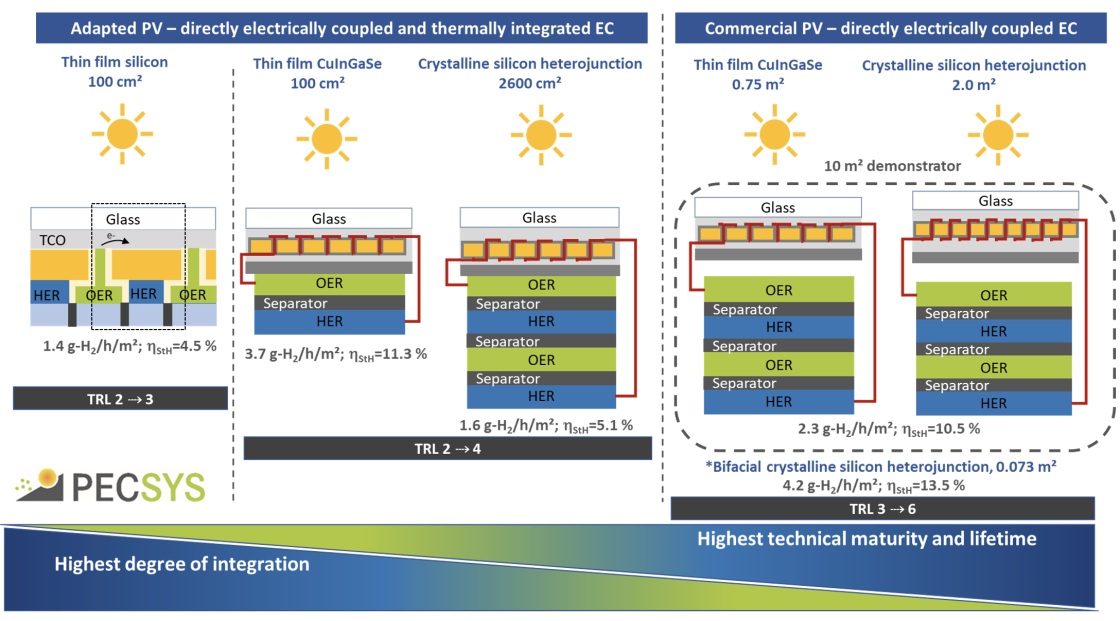Project PECSYS
Technology demonstration of large scale photo-electrochemical system for solar hydrogen production - PECSYS
PECSYS was a 4-year project funded by the European Commission under the Horizon 2020 programme. The project started in January 2017 and ended in December 2020. The project consortium thanks all those that have followed, supported and contributed to the project. We also want to thank the various staff members at the Fuel Cells and Hydrogen 2 Joint Undertaking for their support and advice throughout the project.
The goal of the project PECSYS was to demonstrate a system for the solar driven electrochemical hydrogen generation with an area >10 m². The motivation of the project was to contribute towards cost reductions of low carbon hydrogen production powered by a renewable energy source specifically, solar energy. The PECSYS consortium used predominantly low-cost, established photovoltaic (PV) technologies directly coupled to electrolyser units, instead of photoelectrochemical devices, for water splitting. This way, the substantial learning curve of PV technology could be leveraged and commercially available and/or earth abundant catalysts known from electrolyser technology can be used. Since only adjustments in contacting / interconnection / packaging are required, there was no need to develop an entirely new device thus accelerating the time-to-market. The final demonstrator consisted of several commercial PV modules with an active area >10 m² and produced more than 10 Kg of hydrogen over a nine-month period of operation in Jülich, Germany.
All the public deliverables and links to open access peer reviewed publications from the project can be found on this web site under the Resources tab. Videos of various prototypes developed within the project and the final test array for the demonstrator are available here. The project website shall continue to be updated as more project related results and publications are completed.
Main Results
In the PECSYS project two main approaches were considered for direct solar hydrogen generation using water electrolysis.
In the first approach, PV modules were both directly electrically coupled to and thermally integrated with electrolysers. In this approach, earth abundant materials were used for the photovoltaic and electrolysis components and it could thus be considered as next generation of photovoltaic driven electrolysis operated without solar concentration.
In the second, higher technologically mature, approach, commercial sized photovoltaic (PV) modules were directly coupled to proton exchange membrane (PEM) electrolysers in a so-called cassette configuration to form a modular generation unit. The configuration in PECSYS is unique because the balance of plant was minimised by (i) feeding water to the electrolyser from the cathode side only; (ii) using hydraulics (siphoning effect) and not pumps to provide feed water the electrolyser; (iii) eliminating power management electronics and (iv) eliminating active heating/cooling of the electrolyser.
The schematic below summarises the performance of the different direct solar hydrogen generation approaches investigated in the project.

Solar collection area specific hydrogen production rates (g-H2/h/m²) and solar to hydrogen conversion efficiency (%) of photovoltaic-electrolyser systems investigated in the PECSYS project. The directly electrically coupled and thermally integrated systems used alkaline electrolysers with earth abundant catalysts, while the directly couple systems with commercial PV modules used proton exchange membrane electrolysers with platinum group catalysts
Acknowledgement
“This project has received funding from the Fuel Cells and Hydrogen 2 Joint Undertaking under grant agreement 735218. This Joint Undertaking receives support from the European Union's Horizon 2020 research and innovation programme and Hydrogen Europe and N.ERGHY”

